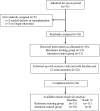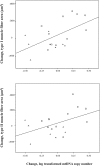Resistance training increases muscle mitochondrial biogenesis in patients with chronic kidney disease
- PMID: 20498251
- PMCID: PMC2879307
- DOI: 10.2215/CJN.09141209
Resistance training increases muscle mitochondrial biogenesis in patients with chronic kidney disease
Abstract
Background and objectives: Muscle wasting, a common complication in chronic kidney disease (CKD), contributes to poor outcomes. Mitochondrial biogenesis is critical for the maintenance of skeletal muscle function and structural integrity. The present study--a secondary analysis from a published randomized controlled trial--examined the effect of resistance exercise training on skeletal muscle mitochondrial (mt)DNA copy number and determined its association with skeletal muscle phenotype (muscle mass and strength).
Design, setting, participants, & measurements: Twenty-three patients with moderate-to-severe CKD were randomized to resistance training (n = 13) or an attention-control (n = 10) group for 12 weeks. After a run-in period of a low-protein diet that continued during the intervention, mtDNA copy number in the vastus lateralis muscle was estimated by quantitative real-time PCR at baseline and 12 weeks.
Results: Participants mean age was 64 +/- 10 (SD) years and median (interquartile range, IQR) GFR 27.5 (37.0) ml/min. There were no differences between groups at baseline. Median (IQR) mtDNA copy number was 13,713 (10,618). There was a significant increase in muscle mtDNA with exercise compared with controls (1306 [13306] versus -3747 [15467], P = 0.01). The change in muscle mtDNA copy number was positively correlated with previously reported changes in types I and II muscle fiber cross-sectional area.
Conclusions: In this pilot study, resistance training was highly effective in enhancing mitochondrial content in patients with moderate-to-severe CKD. This finding suggests that the mitochondrial dysfunction observed with chronic disease could potentially be restored with this exercise modality and should be investigated further.
Figures



Similar articles
-
Reductions in skeletal muscle mitochondrial mass are not restored following exercise training in patients with chronic kidney disease.FASEB J. 2020 Jan;34(1):1755-1767. doi: 10.1096/fj.201901936RR. Epub 2019 Dec 6. FASEB J. 2020. PMID: 31914685
-
Progressive Resistance Exercise Training in CKD: A Feasibility Study.Am J Kidney Dis. 2015 Aug;66(2):249-57. doi: 10.1053/j.ajkd.2014.10.019. Epub 2014 Dec 18. Am J Kidney Dis. 2015. PMID: 25533601 Clinical Trial.
-
Failed upregulation of TFAM protein and mitochondrial DNA in oxidatively deficient fibers of chronic obstructive pulmonary disease locomotor muscle.Skelet Muscle. 2016 Feb 18;6:10. doi: 10.1186/s13395-016-0083-9. eCollection 2016. Skelet Muscle. 2016. PMID: 26893822 Free PMC article.
-
Blood Flow-Restricted Training for Lower Extremity Muscle Weakness due to Knee Pathology: A Systematic Review.Sports Health. 2019 Jan/Feb;11(1):69-83. doi: 10.1177/1941738118811337. Epub 2018 Nov 26. Sports Health. 2019. PMID: 30475660 Free PMC article.
-
Chronic kidney disease and acquired mitochondrial myopathy.Curr Opin Nephrol Hypertens. 2018 Mar;27(2):113-120. doi: 10.1097/MNH.0000000000000393. Curr Opin Nephrol Hypertens. 2018. PMID: 29266014 Review.
Cited by
-
Treatment of chronic kidney disease in older populations.Nat Rev Nephrol. 2024 Sep;20(9):586-602. doi: 10.1038/s41581-024-00854-w. Epub 2024 Jul 8. Nat Rev Nephrol. 2024. PMID: 38977884 Review.
-
Primary skeletal muscle cells from chronic kidney disease patients retain hallmarks of cachexia in vitro.J Cachexia Sarcopenia Muscle. 2022 Apr;13(2):1238-1249. doi: 10.1002/jcsm.12802. Epub 2022 Jan 14. J Cachexia Sarcopenia Muscle. 2022. PMID: 35029054 Free PMC article.
-
Characterising skeletal muscle haemoglobin saturation during exercise using near-infrared spectroscopy in chronic kidney disease.Clin Exp Nephrol. 2019 Jan;23(1):32-42. doi: 10.1007/s10157-018-1612-0. Epub 2018 Jun 30. Clin Exp Nephrol. 2019. PMID: 29961156 Free PMC article.
-
Aerobic Exercise Training in Patients With mtDNA-Related Mitochondrial Myopathy.Front Physiol. 2020 May 21;11:349. doi: 10.3389/fphys.2020.00349. eCollection 2020. Front Physiol. 2020. PMID: 32508662 Free PMC article. Review.
-
Clinical relevance of sarcopenia in chronic kidney disease.Curr Opin Nephrol Hypertens. 2017 May;26(3):219-228. doi: 10.1097/MNH.0000000000000318. Curr Opin Nephrol Hypertens. 2017. PMID: 28198733 Free PMC article. Review.
References
-
- Fouque D, Kalantar-Zadeh K, Kopple J, Cano N, Chauveau P, Cuppari L, Franch H, Guarnieri G, Ikizler TA, Kaysen G, Lindholm B, Massy Z, Mitch W, Pineda E, Stenvinkel P, Trevino-Becerra A, Wanner C: A proposed nomenclature and diagnostic criteria for protein-energy wasting in acute and chronic kidney disease. Kidney Int 73: 391–398, 2008 - PubMed
-
- Coresh J, Byrd-Holt D, Astor BC, Briggs JP, Eggers PW, Lacher DA, Hostetter TH: Chronic kidney disease awareness, prevalence, and trends among U.S. adults, 1999 to 2000. J Am Soc Nephrol 16: 180–188, 2005 - PubMed
-
- Foley RN, Wang C, Ishani A, Collins AJ, Murray AM: Kidney function and sarcopenia in the United States general population: NHANES III. Am J Nephrol 27: 279–286, 2007 - PubMed
-
- Nair KS: Aging muscle. Am J Clin Nutr 81: 953–963, 2005 - PubMed
Publication types
MeSH terms
Substances
Grants and funding
LinkOut - more resources
Full Text Sources
Medical

